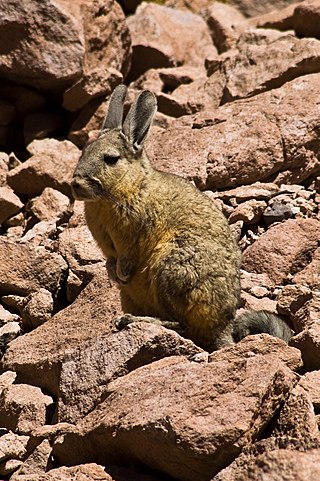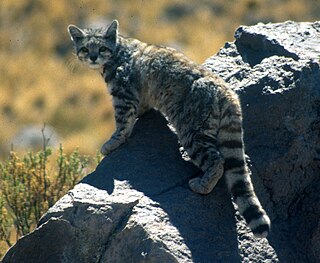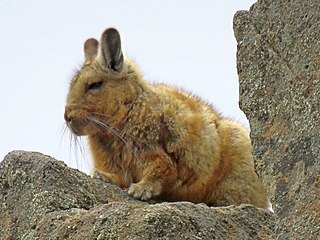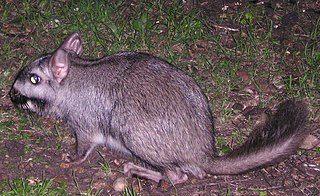
The family Chinchillidae is in the order Rodentia and consists of the chinchillas, the viscachas, and their fossil relatives. This family is restricted to southern and western South America, mostly living in mountainous regions of the Andes but one species living on plains. They are medium to large-sized rodents, weighing from 800 g (28 oz) to 8 kg (18 lb), with strong hind legs and large ears and a bushy tail. All species have thick, soft fur, which is considered valuable in some cultures.

Viscacha or vizcacha are rare rodents of two genera in the family Chinchillidae. They are native to South America and convergently resemble rabbits.

The Andean mountain cat is a small wild cat native to the high Andes that has been listed as Endangered on the IUCN Red List because fewer than 1,500 individuals are thought to exist in the wild. It is traditionally considered a sacred animal by indigenous Aymara and Quechua people.
The golden viscacha rat or golden vizcacha rat is the single species of the genus Pipanacoctomys of the rodent family Octodontidae. It has 92 chromosomes and has been regarded as tetraploid. This octodontid and its sister-species, the plains viscacha rat, may have arisen from the diploid mountain viscacha rat, as a result of the doubling and subsequent loss of some chromosomes. However, some genetic studies have rejected any polyploidism in mammals as unlikely, and suggest that amplification and dispersion of repetitive sequences best explain the large genome size.

The Reserva Provincial La Payunia also known as Payún or Payén is a natural reserve located in the Malargüe Department in the southern part of Mendoza Province, Argentina, about 160 km away from Malargüe city. It was declared as nature preserve in 1988 and has an area of 4,500 km2. La Payunia is home to the many volcanic cones, being noteworthy the Payún Matrú volcano.
Pittier's crab-eating rat is a species of semiaquatic rodent in the family Cricetidae. It is endemic to Venezuela. The natural habitats of this species are rivers and swamps. Its karyotype has 2n = 92 and FNa = 98. This was previously thought to be the highest chromosome number known for a mammal, but it has since been found that the plains viscacha rat or red viscacha rat has 4x = 2n = 102.
Nephelomys auriventer, also known as the golden-bellied oryzomys or Ecuadorian rice rat, is a species of rodent in the genus Nephelomys of family Cricetidae. Oldfield Thomas originally described it, in 1899, as a species of Oryzomys, Oryzomys auriventer, and considered it most similar to Oryzomys aureus. In 1926, a subspecies was described from an Ecuadorian locality, Oryzomys auriventer nimbosus, and it was suggested that O. auriventer was closely related to O. albigularis. This proposal was formalized in 1961 by including O. auriventer within the species O. albigularis, but by 1976 O. auriventer was recognized again as a separate species. In 2006, Oryzomys albigularis and related species, including O. auriventer, were transferred to the new genus Nephelomys. Simultaneously, the former subspecies nimbosus was recognized as a separate species, Nephelomys nimbosus.
Nephelomys levipes, also known as the nimble-footed oryzomys or light-footed rice rat, is a species of rodent in the genus Nephelomys of family Cricetidae. It is found on the eastern slope of the Andes from southeastern Peru into west-central Bolivia in cloud forest at elevations from 1,800 to 3,200 metres. It occurs in the same general area as its congener N. keaysi, but at higher altitudes.

The tricolored brushfinch is a species of bird in the family Passerellidae. It is found in the Andes of central Peru and Ecuador. Its natural habitats are subtropical or tropical moist montane forests and heavily degraded former forest.

The northern viscacha is a species of viscacha, a rodent in the family Chinchillidae. It is known from Peru and Chile, at elevations from 300 to 5000 m, and may also be present in Bolivia.

Lagidium is a genus of rodents in the family Chinchillidae.

The southern viscacha is a species of viscacha, a rodent in the family Chinchillidae found in Argentina, Bolivia, Chile, and Peru. It is a colonial animal living in small groups in rocky mountain areas. It has long ears and hind legs and resembles a rabbit in appearance apart from its long, bushy tail, but is not a lagomorph.

Wolffsohn's viscacha, locally known as chinchillón anaranjado, is a rare species of rodent in the family Chinchillidae. This species occurs in southwestern Argentina and adjacent Chile. It occurs up to about 4,000 m (13,000 ft) above sea level. It is found in rocky outcrops in mountainous areas.

The plains viscacha or plains vizcacha is a species of viscacha, a rodent in the family Chinchillidae. It is the only living species within the genus Lagostomus. It is found in Argentina, Bolivia, and Paraguay. The plains viscacha is the largest species in its family. They construct elaborate burrows that house successive colonies for decades.

Lagostomus is a South American genus of rodents in the family Chinchillidae. It contains a single living species, the plains viscacha, and it is the only Holocene genus in the subfamily Lagostominae.

The plains viscacha rat, plains vizcacha rat, red viscacha rat, or red vizcacha rat is a species of rodent in the family Octodontidae native to Argentina. It is one of three species in the genus Tympanoctomys.

Lagidium ahuacaense is a rodent in the mountain viscacha genus (Lagidium) that occurs in southern Ecuador. First observed in 2005 and formally described in 2009, it occurs more than 500 km (310 mi) north of the nearest previously known population of mountain viscachas in central Peru. Only a single population is known, found on rocky habitats on Cerro El Ahuaca, an isolated granite mountain in southern Ecuador, and as few as several dozen individuals remain. The species is threatened by fires and grazing cattle, and the discoverers recommended its conservation status be assessed as critically endangered.

Battus crassus, the Crassus swallowtail, is a species of butterfly from the family Papilionidae.

Phyla canescens is a species of perennial herbaceous plant in the family Verbenaceae, native to South America. It has been introduced to Australia as an ornamental plant and low-maintenance lawn, but has become naturalised and is considered a serious environmental weed. It is known by several common names including carpet weed, Condamine couch, Condamine curse, fog fruit, frog fruit, hairy fogfruit, lippia, mat grass and no-mow grass.
Chasicobradys is an extinct genus of ground sloths of the family Nothrotheriidae that lived in what is now Argentina. Chasicobradys was discovered in the Arroyo Chasicó Formation, in Buenos Aires Province. It is only known from jaw fragments and teeth, which allowed the identification of this species, and was classified as a member of the nothrotheriid subfamily Nothrotheriinae, which comprises small to medium-sized species of ground sloths.














